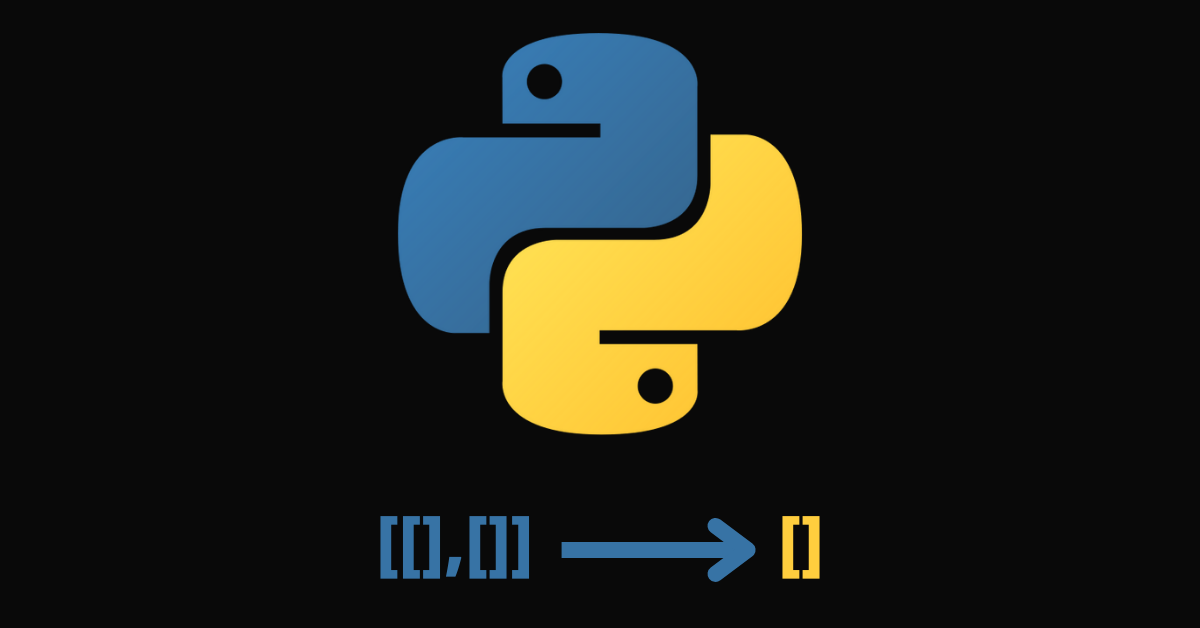Lists are one of the core data structures of Python. Due to their flexibility, there are a lot of things you can do with lists. And one of those things is turning a list of lists into a single list.
It is also possible to turn a list of dictionaries, a list of tuples, or a list of both tuples and dictionaries into a single list. We’ll learn a few ways to do these things in this article.
What We’ll Cover
- How to Flatten a List with the
sum()Function - How to Flatten a List with a Nested
forLoop - How to Flatten a List with List Comprehension
- How to Flatten a List with Numpy
- How to Flatten a List with the
more_itertoolsPackage - Wrapping Up
How to Flatten a List with the sum() Function
You typically use the sum() function to do what its name implies – add numbers together. But you can also use it to flatten out a list of lists into a single list.
The sum() function takes an iterable of numbers you want to add together and an optional starting point:
sum(iterable, starting_point)
If you specify the list of lists you want to flatten as the iterable and an empty list as the starting point, the list will be flattened out. Here’s how to do it:
first_list_of_lists = [[12, 45, 2], [3, 7, 3, 1], [23, 89, 10, 9]]
flattened_first_list_of_lists = sum(first_list_of_lists, [])
print(flattened_first_list_of_lists) # [12, 45, 2, 3, 7, 3, 1, 23, 89, 10, 9]
You can see the list got flattened out.
But this method won’t work for a list of tuples, a list of dictionaries, or a list of tuples and dictionaries because you cannot concatenate those.
Using the sum() function will also not work for a 2-dimensional list containing strings or a 3-dimensional list. You will see how to flatten a list in those circumstances as you read on.
How to Flatten a List with a Nested for Loop
A nested for loop is a for loop inside another for loop. This is how you can flatten out a list of lists for loop:
list_of_lists = [[12, 45, 2], [3, 7, 3, 1], [23, 89, 10, 9]]
flattened_list_of_lists = []
for sublist in list_of_lists:
for num in sublist:
flattened_list_of_lists.append(num)
print(flattened_list_of_lists) # [12, 45, 2, 3, 7, 3, 1, 23, 89, 10, 9]
The code above loops through each dimension of the array and appends them into an empty list I called flattened_list_of_lists with the append() method.
This method would also be ideal for flattening a nested list of strings:
list_of_names = [["Olsen", "Joy"], ["Di Marco", "Ascensio"], ["Modric", "Ann"]]
flattened_list_of_names = []
for sub_list in list_of_names:
for name in sub_list:
flattened_list_of_names.append(name)
print(flattened_list_of_names)
Using a nested loop would also let you flatten a list of tuples, a list of dictionaries, or a list of lists, tuples, and dictionaries combined.
Flattening a list of tuples:
list_of_tuples = [1, 2, 3, (4, 5), (2, 4, 24)]
flattened_list_of_tuples = []
for sub_list in list_of_lists:
for num in sub_list:
flattened_list_of_tuples.append(num)
print(flattened_list_of_tuples) # [12, 45, 2, 3, 7, 3, 1, 23, 89, 10, 9]
Flattening a list of dictionaries:
list_of_dicts = [ {1, 2, 3}, { "d": 4, "e": 5, "f": 6}]
flattened_list_of_dicts = []
for sub_list in list_of_dicts:
for num in sub_list:
flattened_list_of_dicts.append(num)
print(flattened_list_of_dicts) # [1, 2, 3, 'd', 'e', 'f']
Flattening a list containing list, tuple, and dictionary:
multi_data_list = [[1, 2, 3], (4, 5, 6), {7, 8, 9}, {"a": 1, "b": 2, "c": 3, "z": 0}]
flattened_multi_data_lists = []
for sub_list in multi_data_list:
for data in sub_list:
flattened_multi_data_lists.append(data)
print(flattened_multi_data_lists)
How to Flatten a List with List Comprehension
List comprehension helps you create a list from a string or another list. So, it’s possible to create a new list from a list of lists. Here’s how the syntax for list comprehension looks:
[expression for element in iterable_data if condition == True]
Remember that you can iterate through strings, so you can create a list from a string this way:
my_str = "freeCodeCamp"
list_from_letters = [letter for sub_list in my_str for letter in sub_list]
print(list_from_letters) # ['f', 'r', 'e', 'e', 'C', 'o', 'd', 'e', 'C', 'a', 'm', 'p']
You can also create a list from a list of lists this way – flattening the list in the process:
list_of_names = [["Olsen", "Joy"], ["Di Marco", "Ascensio"], ["Modric", "Ann"]]
flattened_names = [name for sub_list in list_of_names for name in sub_list]
print(flattened_names) # ['Olsen', 'Joy', 'Di Marco', 'Ascensio', 'Modric', 'Ann']
How to Flatten a List with Numpy
You can use the concatenate() function of the numpy library to flatten a list this way:
import numpy as np
first_list_of_lists = [[1, 2], [4, 5]]
second_list_of_lists = [[6, 7], [8, 9]]
flattened_first_list_of_lists = np.concatenate(first_list_of_lists)
flattened_second_list_of_lists = np.concatenate(second_list_of_lists)
print(flattened_first_list_of_lists) # [1 2 4 5]
print(flattened_second_list_of_lists) # [6 7 8 9]
How to Flatten a List with the more_itertools Package
The more_itertools package is a set of utilities that provides functions and methods for looping through any iterable data in Python. You can install it by running pip install more_itertools or pip3 install more_itertools.
more_itertools has a flatten() function for flattening a list:
from more_itertools import flatten
list_of_lists = [[2, 4, 5], [3, 9, 5, 2], [2, 4, 1, 2 ]]
flattened_list = list(flatten(list_of_lists))
print(flattened_list) # [2, 4, 5, 3, 9, 5, 2, 2, 4, 1, 2]
If you also have a list that has deeply nested lists, more_itertools provides a collapse() function you can use to break all of them into one single list:
from more_itertools import collapse
list_of_lists_2 = [[1, 2], [[3, 4]], [5, [6, 7]]]
flattened_list_of_lists_2 = list(collapse(list_of_lists_2))
print(flattened_list_of_lists_2) # [1, 2, 3, 4, 5, 6, 7]
Wrapping Up
Flattening a list is not an uphill task with the availability of the sum() function, list comprehension, and libraries like Numpy and more_itertools.
Even if you don’t want to do it in the “Pythonic way”, you can use a nested for loop as you saw here.
And if you have a list with deeply nested lists or lists, the collapse() function of more_itertools can help you flatten them out.
If you enjoyed reading this article, don’t hesitate to share it with your friends and family.

